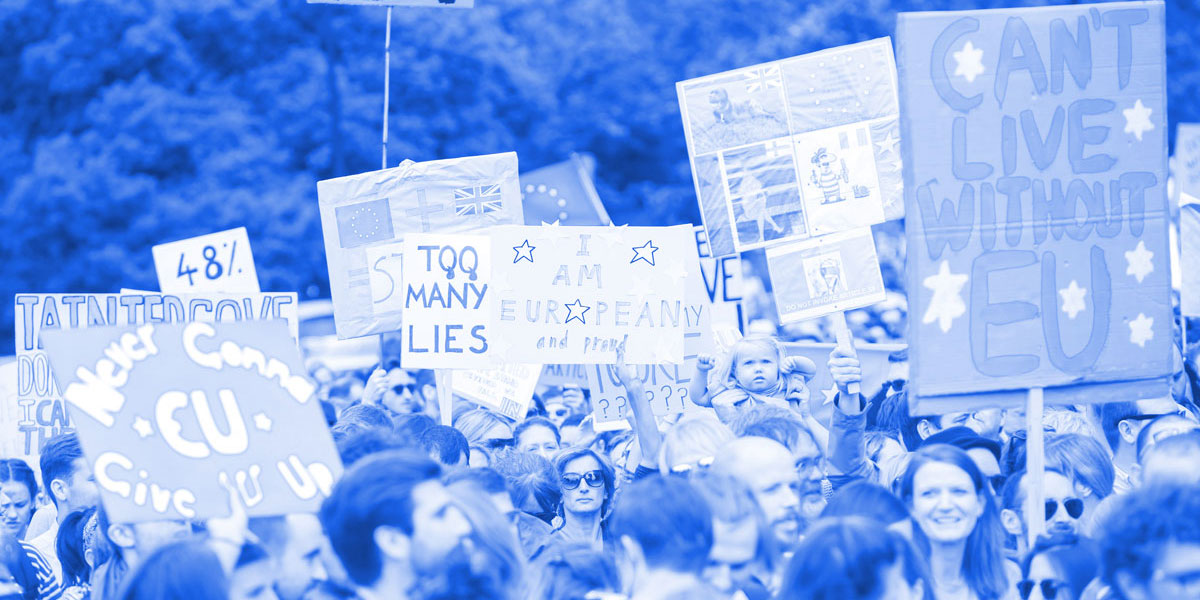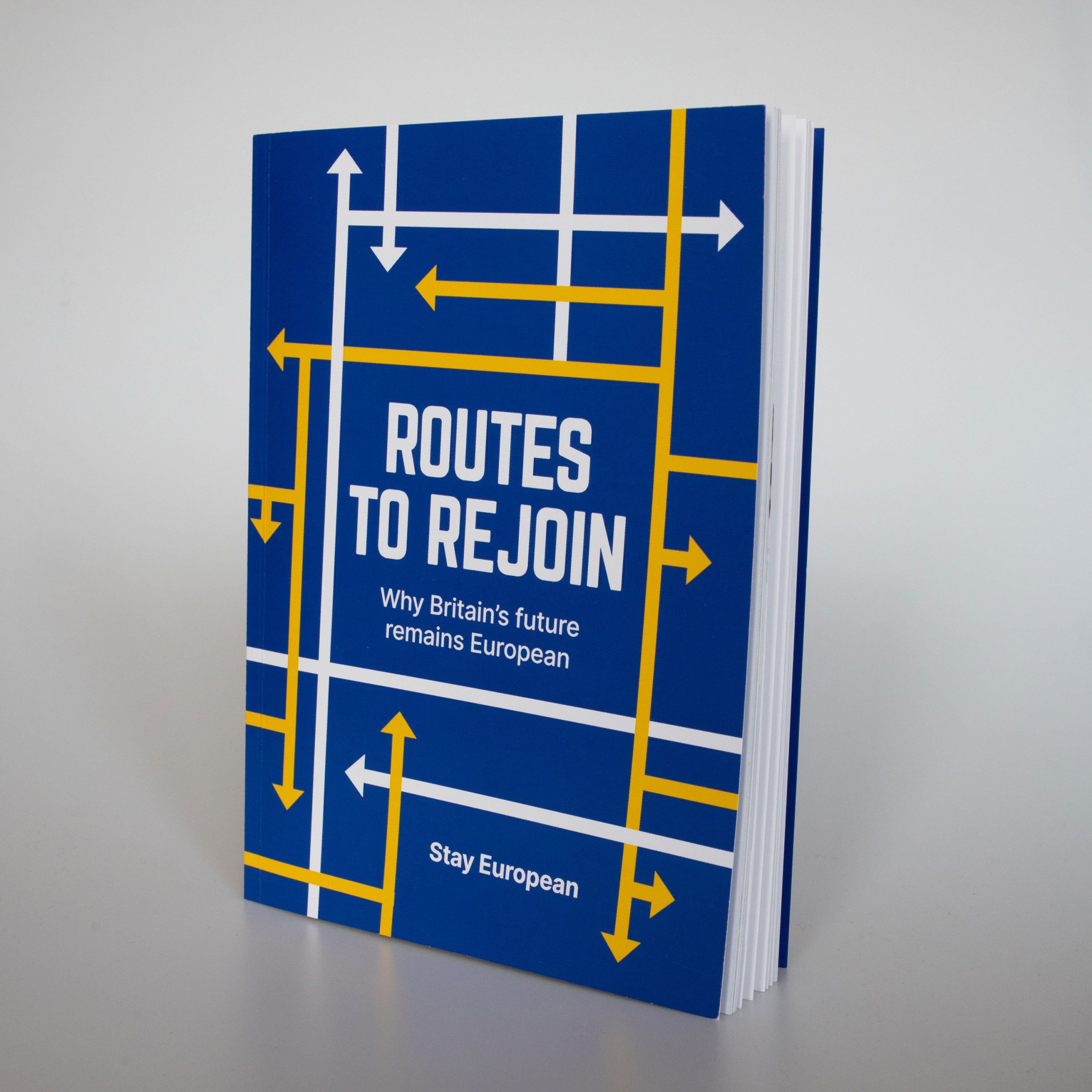Five years on from the disastrous referendum result, we still believe Britain’s future is in Europe.
Why? Because Brexit isn’t working. Because it will only get worse from here as more of the Brexit deal comes into effect. And because Britain still has Europe’s biggest pro-EU movement – and we’re not going away.
Routes to Rejoin is our effort to map out the possibilities of the next few years, and which combinations of circumstances could put Britain on the path back to EU membership. It’s not another ‘looking back’ book – it’s about where we go from here. We hope it will be a vital strategic resource for the years ahead.
You can now read Routes to Rejoin in full and for free on this website – the text begins below. There is also an ebook version for download.
Introduction
Britain has the biggest pro-EU movement in Europe – yet it is now further out of the EU than even the most ardent Brexiters advocated during the referendum campaign five years ago.
Despite a narrow 52-48% win for Leave in the 2016 referendum and the crisis that followed, the government continues to pursue a policy not only of Brexit, but of the hardest of hard Brexits.
While they hide behind the ‘will of the people’, there is not – and never has been – a majority in favour of this plan. Something has got to give.
If you’re reading this, you know the story of how we got here. This book isn’t about that – it’s about how we can start to undo the damage.
It is about developing a strategy for those of us who want to rejoin the EU, a larger number of people than is commonly thought, as we will see. It is about key moments ahead where organised campaigning has the potential to make a difference. We can’t change history, but we can still look for ways to change the future.
There is no ‘royal road’ to rejoin – no single strategic focus that stands out above all others, at least right now. But we believe there are many possible routes. In this book we map out these routes, indicate the ones we believe to be more or less likely, and mark important dates when we expect forks in the road.
Some critics, including (if we’re honest) some sections of the pro-EU movement, believe that this work is pointless. They say there is no chance of rejoining the EU – or if they do not quite dare to argue that outright, they say there is no chance ‘in the short term’, ‘in the foreseeable future’, etc.
True, it isn’t going to be this week, or even this year. But to consign rejoining to a nebulous ‘someday’ undersells the possibilities of the next few years.
As the pandemic comes to an end, many Brexit chickens will come home to roost – not least the loss of free movement and the new obstacles to travelling and working in Europe. Do you believe that will have no effect?
There is a general election scheduled for 2024 – though it is widely believed it may come sooner, perhaps 2023. Are we giving up on that election before it is fought?
The Brexit deal includes a renegotiation period in the middle of the decade that gives an opportunity for closer alignment, at a time when we know Brexit will have been exposed as a disaster and a wide range of industries will be screaming about how unworkable the deal has been. Don’t we want to make the most of that moment? (See ‘Timeline’ for more key dates ahead.)

Brexit is not ‘done’ (see chapter 1). It is still happening, still being implemented, negotiated and renegotiated – it is not an event but a perpetual process. In the case of Northern Ireland, it is simply unworkable, at least in its current ‘hard Brexit’ form. Brexit will be with us, causing crisis after crisis, until it is reversed. Chapter 2 documents some of the economic impact so far, with more soon to come.
In chapter 3 we look at British public opinion, which (despite how it is usually portrayed) continues to be largely pro-EU and believes that Brexit is going badly. We look especially at young people’s overwhelming support for EU membership and continuing opposition to Brexit.
Taking a closer look at the Brexit deal in chapter 4, we see how far Britain has moved out of the orbit of the EU compared to almost any other European country, and the problems this extreme position is causing. We look at how much worse things will get as the pandemic ends and more border rules come into force, and how pressure will build ahead of the renegotiation period (chapter 5).
We need a change of government (chapter 6) ahead of this renegotiation if it is to build a path towards rejoining the EU. The most likely alternative route is the break-up of Britain (chapter 7) and rejoining in fragments.
Finally in chapter 8 we explore the risks of new trade deals as the government attempts to geopolitically realign the UK into other global trade blocs, and then conclude by arguing that rejoining the EU is possible – and that, unlikely as it may seem right now, the chances are ultimately much better than the chances of making Brexit work.
No one knows the future, but enough is scheduled already to sketch an outline of the likely effects and crunch points ahead. To find our route to rejoin, we need to think through a strategy not for the next few weeks but for the next five years and beyond, and stay ready to fight for what we believe in as opportunities present themselves.
This book is for everyone who will never give up on Europe.

